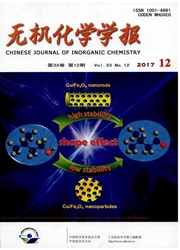

 中文摘要:
中文摘要:
锂硫电池的商用化受到硫和多硫化锂低的电导率、多硫化锂在有机电解液中的溶解、放电过程中硫的体积膨胀等因素的制约。我们通过自模板法制备了具有石墨化孔壁结构的介孔碳纳米纤维(MCNn,并利用这种结构将硫和多硫化锂封装在碳骨架内。具有石墨化孔壁结构的一维MCNF能够在循环中为硫和多硫化锂提供良好的导电网络。MCNF中小的介孔能够抑制长链多硫化锂的扩散。另外,MCNF大的孔容能够负载比较多的硫,并且能够为硫的放电膨胀提供足够的纳米空间。本工作制备的MCNF-硫纳米复合材料在0.8A·g-1的电流密度下,经过100次循环后仍有820mAh·g-1的比容量。
 英文摘要:
英文摘要:
Rechargeable lithium-sulfur batteries' commercial applications are still hindered by some major basic obstacles, such as the low electrical conductivity of sulfur and polysulfides, the dissolution of lithium polysulfides in organic electrolyte, and the volume expansion of sulfur during discharge. In this study, a mesoporous carbon nanofiber (MCNF) with graphitic pore wall prepared by an easy self-template strategy was designed to encapsulate sulfur and polysulfides in the carbon framework. The one-dimensional MCNF with graphitic pore wall can provide an effective conductive network for sulfur and polysulfides during cycling. The small mesopore of MCNF can also restrain the diffusion of long-chain polysulfides. Furthermore, MNCF with high volume can encapsulate a relatively high amount of sulfur and provide internal void space to accommodate volume expansion during discharge. The resulting MCNF-sulfur nanocomposite shows high and stable specific capacities of 820 mAh·g-1 after 100 cycles at a rate of 0.8 A.g-1.
 同期刊论文项目
同期刊论文项目
 同项目期刊论文
同项目期刊论文
 Fabrication of Hierarchical Macroporous/Mesoporous Carbons via the Dual-Template Method, and the Res
Fabrication of Hierarchical Macroporous/Mesoporous Carbons via the Dual-Template Method, and the Res Morphology-controlled synthesis of nanostructured zinc hydroxide fluoride via a microwave-assisted i
Morphology-controlled synthesis of nanostructured zinc hydroxide fluoride via a microwave-assisted i Influence of the pore structure parameters of mesoporous anatase microspheres on their performance i
Influence of the pore structure parameters of mesoporous anatase microspheres on their performance i Preparation of Graphene Coated Carbon Nanotube-Sulfur Composite and Its Performance for Lithium-Sulf
Preparation of Graphene Coated Carbon Nanotube-Sulfur Composite and Its Performance for Lithium-Sulf Ultra-Long-Term Cyclability of Li4Ti5O12/Graphene Nanocomposite Anode Material with Three-Dimensiona
Ultra-Long-Term Cyclability of Li4Ti5O12/Graphene Nanocomposite Anode Material with Three-Dimensiona Activated carbon with ultrahigh specific surface area synthesized from natural plant material for li
Activated carbon with ultrahigh specific surface area synthesized from natural plant material for li Fe2O3 nanocrystals anchored onto graphene nanosheets as the anode material for low-cost sodium-ion b
Fe2O3 nanocrystals anchored onto graphene nanosheets as the anode material for low-cost sodium-ion b Mesoporous NiO with a single-crystalline structure utilized as a noble metal-free catalyst for non-a
Mesoporous NiO with a single-crystalline structure utilized as a noble metal-free catalyst for non-a 期刊信息
期刊信息
